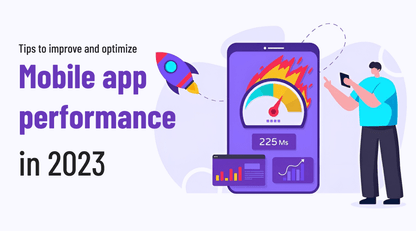In today's digital age, mobile apps have become a vital component of any successful business strategy. They offer a direct and convenient way to engage with customers, increase brand visibility, and drive revenue. When it comes to mobile app development, businesses have several options to choose from, including native apps, web apps, and hybrid apps. In this blog, we will explore why hybrid mobile apps can be a good idea for your business in 2023.
Hybrid mobile apps are applications that combine elements of both native and web apps. They are built using web technologies such as HTML, CSS, and JavaScript, wrapped in a native container that allows them to be deployed on multiple platforms. Hybrid apps offer a middle ground between the platform-specific nature of native apps and the cross-platform capabilities of web apps.

Benefits of Hybrid Mobile Apps
Cost-effectiveness
One of the significant advantages of hybrid mobile apps is their cost-effectiveness. By using a single codebase for multiple platforms, businesses can save time and resources on development and maintenance. This approach eliminates the need to build separate apps for iOS and Android, reducing the overall development costs.
Faster time-to-market
Hybrid apps can accelerate the time-to-market compared to native apps. With hybrid frameworks like React Native or Flutter, developers can write code once and deploy it on multiple platforms simultaneously. This streamlined development process enables rapid prototyping, quick iterations, and faster app releases.
Enhanced user experience
Hybrid apps can deliver a native-like user experience with smooth performance and responsiveness. They have access to device capabilities and features through plugins and APIs, allowing businesses to leverage functionalities like camera access, geolocation, push notifications, and more. Hybrid apps can offer a seamless and immersive user experience similar to native apps.
Wide audience reach
With hybrid apps, businesses can target a wide audience across different platforms. By developing a single app that works on both iOS and Android, businesses can maximize their reach and engage with a larger user base. Hybrid apps can be easily distributed through app stores, making them accessible to a broader audience.
Key Factors to Consider while building hybrid apps
While hybrid mobile apps offer numerous benefits, there are some key factors to consider for a successful implementation:
App performance and optimization
Do you know the importance of mobile app optimization? Balancing native and web technologies is crucial for achieving optimal app performance. Careful optimization of code and efficient use of device resources can help overcome performance limitations and provide a smooth user experience.
User experience design
Consistency in design across platforms is vital for a seamless user experience. Businesses need to ensure that their hybrid apps provide a consistent look and feel, while also customizing the user interface for different devices and operating systems.
Security considerations
Data security is a critical aspect of mobile app development. Businesses should prioritize implementing encryption techniques, secure communication protocols, and proper authentication mechanisms to protect user data and maintain user trust.
Success Stories of Hybrid Mobile Apps
Several well-known apps have been developed using hybrid technologies, showcasing their success in the market:
The popular photo-sharing app, Instagram, started as a hybrid app. It allowed the development team to build a cross-platform app quickly, reaching a large user base early on. Later, they transitioned to a native app to optimize performance for specific platforms.
Uber
Uber, the renowned ride-hailing service, initially used hybrid app development to scale rapidly across various markets. Hybrid technology enabled them to launch their app on both iOS and Android simultaneously, catering to a global audience.
MarketWatch
MarketWatch, a leading financial news and information website, wanted to extend their services to mobile users. They chose to develop a hybrid app using the React Native framework. The hybrid app allowed MarketWatch to efficiently deliver real-time financial news, market data, and personalized portfolios to both iOS and Android users.
Challenges and Limitations of hybrid applications
While hybrid mobile apps have numerous benefits, they also face some challenges and limitations. One of the main challenges of hybrid apps is their performance limitations. Hybrid apps typically rely on web technologies wrapped in a native container. While this approach allows for code reuse and cross-platform compatibility, it can introduce performance issues.
Compared to native apps, hybrid apps may experience slower rendering, reduced responsiveness, and limitations in accessing device-specific features. These factors can result in a potentially less optimal user experience, especially for applications that require high-performance or intensive graphics.
Another limitation of hybrid apps is their limited access to native features. Hybrid app frameworks provide plugins or libraries to access certain native device capabilities such as camera, GPS, or push notifications.
However, not all native features may be accessible through these frameworks, and the functionality provided by plugins may not be as comprehensive or reliable as native solutions. This can pose challenges when developing applications that heavily rely on specific device features or require seamless integration with the device's operating system.
Performance limitations
Hybrid apps may not always match the performance of native apps, especially when dealing with complex animations or heavy graphics. However, advancements in hybrid frameworks are continually improving performance capabilities.
Dependency on third-party frameworks
Hybrid app development often relies on third-party frameworks and plugins. This dependency can introduce compatibility issues and may require additional effort to keep up with updates and changes.
Difficulty in implementing complex UI/UX elements
Building complex UI/UX elements, such as intricate animations or custom transitions, can be more challenging in hybrid apps compared to native development. However, with the right expertise and resources, it is still achievable.
How to Get Started with Hybrid Mobile Apps?
To get started with hybrid mobile apps, businesses should follow these steps:
Identify business goals and app requirements
Clearly define the objectives and functionality required for your app. Identify the target audience, desired features, and key performance indicators to align your app development strategy with business objectives.
Choose the right hybrid app framework
Research and evaluate different hybrid app frameworks like React Native, Flutter, or Ionic, based on your project requirements and team expertise. Select a framework that provides the necessary tools, resources, and community support.
Hire skilled hybrid app developers or outsource
Ensure you have a team of experienced hybrid app developers who are proficient in the chosen framework. You can hire mobile app developers who have worked on similar projects as yours. Alternatively, consider outsourcing the development to a reputable app development company with expertise in hybrid app development.
Conduct thorough testing and quality assurance
Perform comprehensive testing across various devices and platforms to ensure the app functions seamlessly and meets user expectations. Test for performance, usability, security, and compatibility to deliver a high-quality app.
Final Thoughts
In 2023, hybrid mobile apps present a compelling option for businesses aiming to provide excellent user experiences, expand their reach, and optimize development costs. By leveraging the benefits of hybrid apps, businesses can achieve faster time-to-market, cost-effectiveness, and wide audience reach. While challenges exist, the ever-evolving hybrid app development landscape and success stories of notable apps demonstrate the potential for businesses to thrive using hybrid mobile apps.
By aligning app strategy with business objectives and following best practices, businesses can seize the opportunities offered by hybrid mobile apps and stay ahead in the competitive digital landscape of 2023.
Consider factors such as performance expectations, access to device features, and long-term maintenance and scalability. By evaluating these factors and understanding the trade-offs, you can make an informed decision about whether hybrid app development is the right approach for your business. ThinkODC is a top mobile app development company offering out-of-the-box solutions to the clients worldwide. You can hire dedicated developers from us to get the best solutions.


